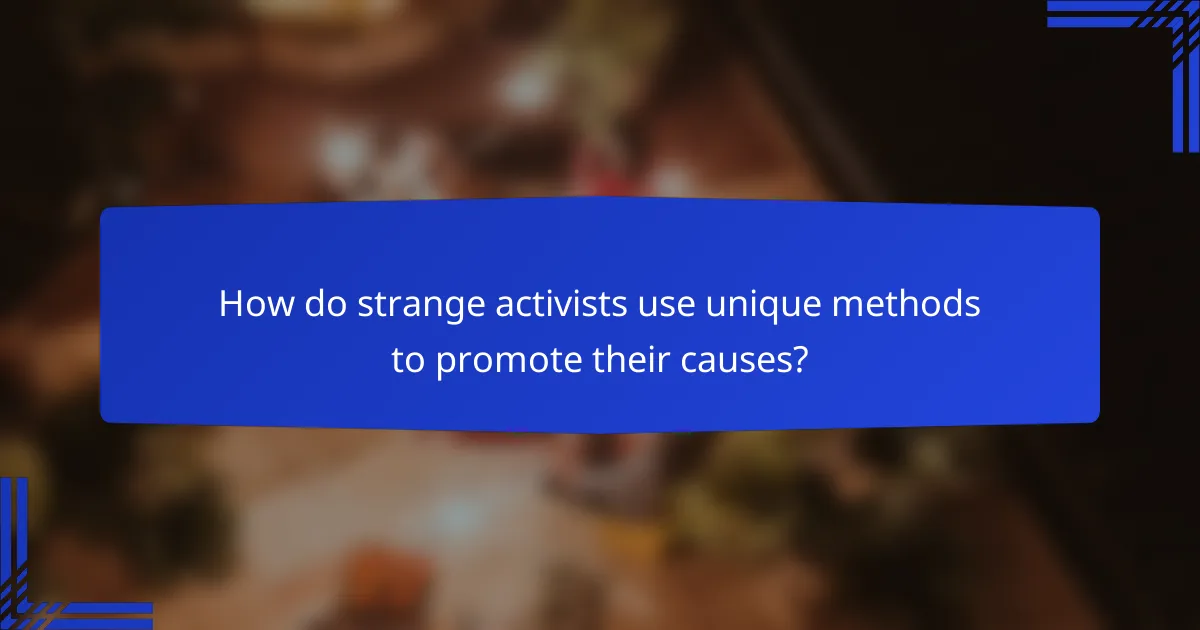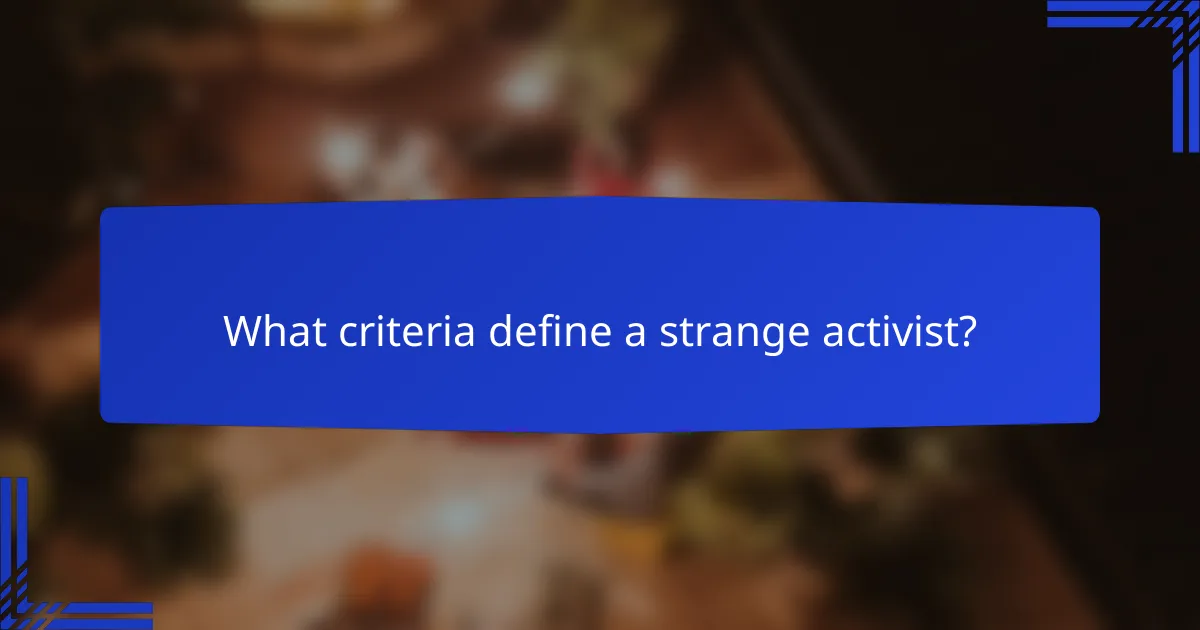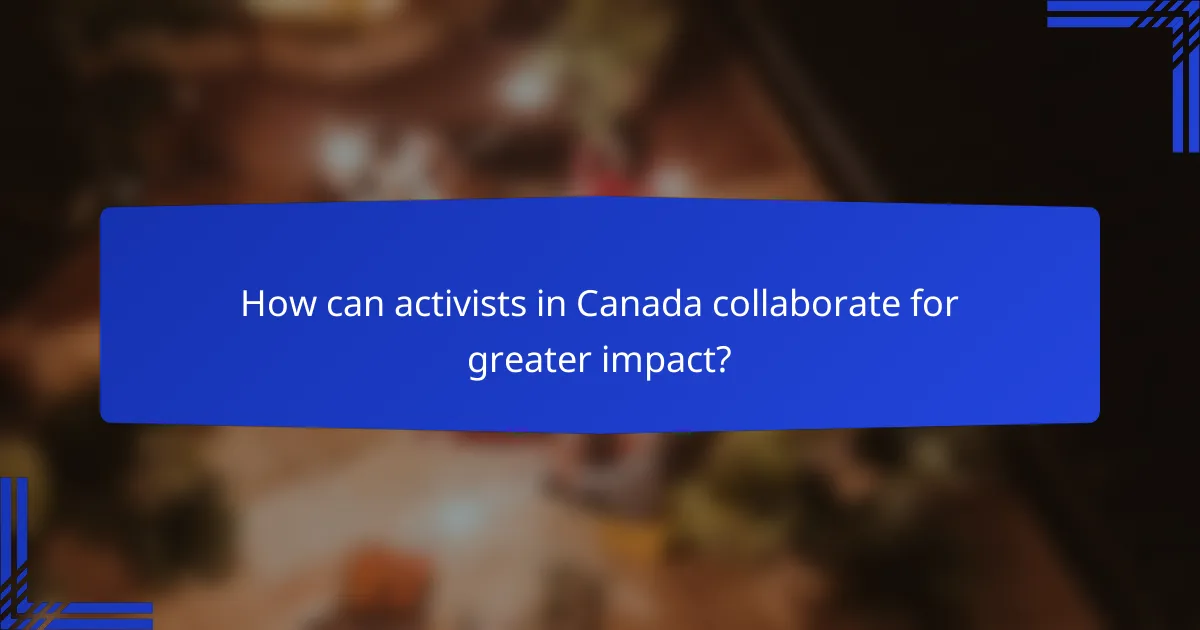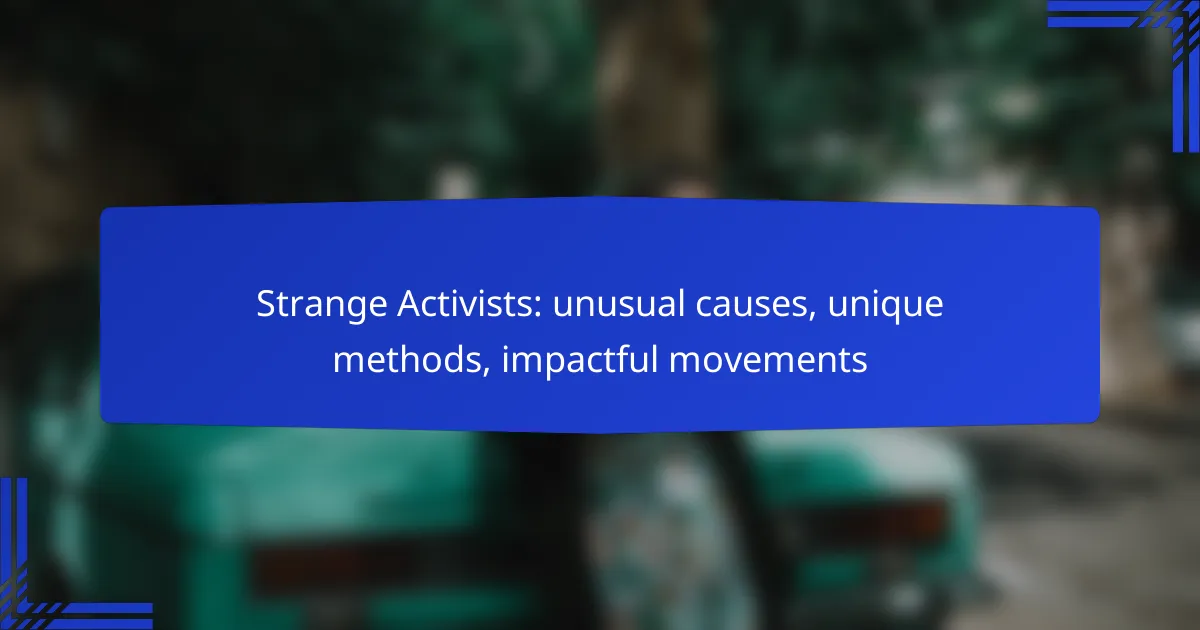Strange activists are redefining the landscape of social change by championing unconventional causes and employing innovative methods to engage the public. From climate justice to Indigenous rights, these movements leverage creativity to provoke thought and inspire action, often challenging societal norms in the process. Their unique approaches not only raise awareness but also create memorable experiences that resonate deeply with diverse audiences.

What unusual causes are being championed by activists in Canada?
In Canada, activists are increasingly focusing on unconventional causes that reflect unique social and environmental issues. These movements often employ innovative methods to raise awareness and drive change, addressing topics such as climate justice, Indigenous rights, animal welfare, and social equity.
Climate change and environmental justice
Activists in Canada are tackling climate change through initiatives that emphasize environmental justice, ensuring that marginalized communities are not disproportionately affected by environmental degradation. This includes advocating for policies that promote sustainable practices and equitable resource distribution.
Many groups organize protests, educational campaigns, and community clean-up events to engage the public. For example, the Fridays for Future movement encourages students to participate in climate strikes, raising awareness about the urgency of climate action.
Indigenous rights and land reclamation
Indigenous activists in Canada are championing the rights of First Nations and advocating for land reclamation. This movement seeks to restore control over traditional territories and protect sacred sites from industrial exploitation.
Methods include legal challenges, public demonstrations, and cultural events that highlight Indigenous heritage. Notable actions, such as the Wet’suwet’en protests against pipeline construction, have garnered national attention and sparked discussions about Indigenous sovereignty.
Animal rights and veganism
Animal rights activists in Canada are promoting veganism as a means to combat animal cruelty and environmental harm. This movement emphasizes the ethical treatment of animals and the environmental benefits of plant-based diets.
Campaigns often include outreach programs, cooking classes, and social media initiatives to educate the public about the impacts of animal agriculture. Events like Vegan Fest showcase local vegan businesses and foster community engagement around ethical eating.
Social justice and anti-racism
Social justice activists in Canada are addressing systemic racism and advocating for equity across various sectors, including education, healthcare, and law enforcement. This movement seeks to dismantle oppressive structures and promote inclusivity.
Activists utilize a range of strategies, from grassroots organizing to policy advocacy. Initiatives like Black Lives Matter Canada have mobilized communities to confront racial injustices and demand accountability from institutions.

How do strange activists use unique methods to promote their causes?
Strange activists leverage unique methods to capture attention and drive engagement for their causes. By employing unconventional tactics, they aim to provoke thought, inspire action, and create memorable experiences that resonate with the public.
Guerrilla art installations
Guerrilla art installations involve creating unexpected art pieces in public spaces to draw attention to social issues. These installations can range from thought-provoking murals to interactive sculptures, often placed in high-traffic areas to maximize visibility. For instance, a temporary installation might highlight environmental concerns by using recycled materials to create a striking visual representation of pollution.
When planning a guerrilla art project, consider the message you want to convey and the location’s relevance to that message. Ensure you have any necessary permissions to avoid legal issues, and think about how the installation can encourage public interaction or dialogue.
Flash mobs and performance art
Flash mobs and performance art are spontaneous gatherings where participants perform a choreographed act to raise awareness about a cause. These events can be entertaining and surprising, often taking place in public spaces like parks or shopping centers. For example, a flash mob might dance to a song with lyrics that promote social justice, drawing a crowd and sparking conversations.
To organize a successful flash mob, recruit participants who are enthusiastic about the cause and can commit to rehearsals. Choose a location that allows for a large audience and consider the timing to maximize impact. Be prepared for potential disruptions, and ensure that the performance aligns with the message you wish to convey.
Viral social media campaigns
Viral social media campaigns utilize engaging content to spread awareness rapidly across platforms like Instagram, Twitter, and TikTok. These campaigns often include hashtags, challenges, or shareable graphics that encourage users to participate and spread the message. A notable example is the Ice Bucket Challenge, which raised significant funds and awareness for ALS.
To create a successful viral campaign, focus on crafting a compelling story or challenge that resonates with your audience. Use eye-catching visuals and clear calls to action to encourage sharing. Monitor engagement and be ready to adapt your strategy based on audience feedback and trends to maintain momentum.

What are some impactful movements led by unconventional activists?
Unconventional activists have sparked significant movements by employing unique methods to draw attention to their causes. These activists often challenge societal norms and utilize creative strategies to engage the public and influence change.
Extinction Rebellion’s civil disobedience
Extinction Rebellion (XR) employs civil disobedience to confront climate inaction. Their tactics include nonviolent protests, road blockades, and sit-ins, aiming to disrupt daily life and attract media attention to the climate crisis.
By strategically targeting high-traffic areas and government institutions, XR seeks to pressure authorities into declaring a climate emergency and taking immediate action. Participants often emphasize the urgency of the situation, highlighting the need for systemic change.
Anonymous for the Voiceless’ outreach
Anonymous for the Voiceless (AV) focuses on animal rights through public outreach and activism. Their signature method involves “Cube of Truth” events, where activists display graphic footage of animal exploitation while wearing masks to symbolize anonymity.
This approach aims to provoke emotional responses from passersby, encouraging conversations about animal welfare and veganism. AV emphasizes the importance of empathy and education in promoting a plant-based lifestyle.
Fridays for Future’s school strikes
Fridays for Future (FFF) is a youth-led movement that organizes school strikes to demand climate action from governments. Students skip school on Fridays to protest, raising awareness about the urgent need for environmental policies.
This grassroots movement has gained international traction, inspiring millions of young people to participate. FFF encourages students to engage with local leaders and advocate for sustainable practices, emphasizing that collective action can lead to significant change.

What criteria define a strange activist?
Strange activists are individuals or groups who adopt unconventional approaches to advocate for causes that may be considered niche or unusual. Their methods often stand out due to their creativity, humor, or unexpected tactics, which can draw attention to issues that might otherwise be overlooked.
Unconventional methods of protest
Strange activists frequently employ unique methods of protest that challenge traditional forms of activism. Examples include flash mobs, guerrilla gardening, and art installations in public spaces. These tactics can capture media attention and engage the public in ways that standard protests may not.
For instance, a group might organize a silent protest where participants wear masks and hold signs in a busy urban area, creating a striking visual impact. Such methods can provoke thought and discussion, making the cause more memorable.
Focus on niche causes
Many strange activists concentrate on niche causes that may not receive mainstream attention. These can range from advocating for the rights of specific animal species to promoting obscure cultural practices. By focusing on these unique issues, they can carve out a distinct identity and gather a dedicated following.
For example, activists might campaign for the preservation of a rare plant species or raise awareness about the environmental impact of a little-known industry. This targeted approach can resonate deeply with specific communities and foster passionate support.
Community engagement and grassroots organizing
Strange activists often prioritize community engagement and grassroots organizing to build a strong base of support. They may host workshops, community art projects, or local events that invite participation and foster connections among like-minded individuals. This approach helps to create a sense of belonging and shared purpose.
Additionally, leveraging social media platforms can amplify their message and mobilize supporters quickly. Activists can use these tools to share updates, coordinate events, and encourage community involvement, making their movements more impactful and far-reaching.

How can activists in Canada collaborate for greater impact?
Activists in Canada can enhance their impact by forming alliances and sharing resources across various movements. This collaboration allows for pooling expertise, broadening outreach, and amplifying voices on shared issues.
Building coalitions across movements
Building coalitions involves uniting different activist groups around common goals. This can be achieved through regular meetings, joint campaigns, and shared resources, fostering a sense of community and purpose.
Consider organizing events that highlight overlapping issues, such as climate change and social justice. By showcasing how these causes intersect, activists can attract a wider audience and create a stronger collective voice.
Effective coalitions often establish clear communication channels and defined roles for each member organization. This clarity helps to avoid misunderstandings and ensures that all parties are working towards the same objectives.
